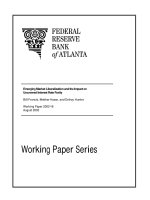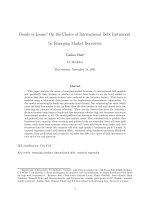why emerging market is important
Bạn đang xem bản rút gọn của tài liệu. Xem và tải ngay bản đầy đủ của tài liệu tại đây (231.78 KB, 11 trang )
Global Capital Market – Lecture 1W
Capital Market Theories
Emerging Market Finance CAU MBA
CAU
Wonil Lee, Ph.D, & CFA
Why Emerging Market is important?
April, 2015
2008년 글로벌 금융위기 이후, ‘New Normal’이 새로운 패러다임으로 부상
- 선진국에서 신흥국으로 경제 중심 변화
‘New Normal’ 패러다임 하 투자방안
- 신흥국 주식 투자, 안전자산으로의 자산배분
위기 이전 : Old Normal
부의 이전 : 선진국으로
고성장
과소비, 낮은 저축률
레버리지 가속화
규제완화, 글로벌화 지속
금리하락
낮은 물가
위기 이후 : New Normal
부의 이전 : 신흥국 으로
저성장 시대
소비감소, 저축률 증가
디-레버리지
규제강화, 탈 글로벌화
장기적으로 금리상승
장기적으로 물가상승
2
Economic Paradigm Shift: New Normal!!
* Source : Bloomberg, Citi Research
** % of GDP
Europe
2012 2014F
GDP성장률
2.4 3.4
CPI
5.3 5.2
경상수지**
0.0 -1.6
재정수지**
-1.7 -3.3
Africa/
MidEast
2012 2014F
GDP성장률
5.2 5.7
CPI
5.0 6.0
경상수지**
10.6 6.1
재정수지**
3.4 -2.2
Asia
2012 2014F
GDP성장률
6.2 6.5
CPI
3.9 4.0
경상수지**
1.7 1.3
재정수지**
-2.4 -2.2
LatAm
2012 2014F
GDP성장률
2.4 3.9
CPI
5.8 5.9
경상수지**
-1.7 -1.9
재정수지**
-2.3 -2.5
EM
2012 2014F
GDP성장률(%)
4.7 5.4
CPI(%)
4.6 4.8
경상수지**
1.8 0.8
재정수지**
-1.7 -2.5
DM
2012 2014F
GDP성장률
1.0 2.2
CPI
1.4 0.9
경상수지**
-0.1 -0.3
재정수지**
-5.2 -3.1
Economic Power moves from West to East: DM to EM
3
EM are Critical Mass in the World Economy
EM should have a 25 – 40% allocation in a global equity portfolio.
For the past 30 years, EM have played key growth engine for the world
economy.
EM countries have real strengths – particularly in exports and capital
spending – that are vital ingredients for high and dynamic rates of
economic growth.
EM countries now collectively account for 38% of global GDP,
compared with only 18% in 1995; about 50% of global exports,
compared with 27% in 1990; and 50% of global capital spending,
compared with 26% in 1990.
EM have been major source of global growth
Historically, EM have been growing fast such as the US in 1800s,
Japan in 1960-80s, China in 2000, etc.
EM tends to have long term population growth so abundant labor
supply and tends to have less debt compared with developed markets
EM are newly industrializing center to produce less sophisticated
commodities for developed markets
In the short run, EM are not stable financially but growing fast in the
long term
EM are less correlated with developed markets – good diversification
Main Drivers of EM Strength
Two main trends, (1) emergence of China as a major economic
powerhouse, and (2) population growth in EM.
China becomes the world’s largest exporter of tradable goods in 2010,
bypassing Germany.
China has massive foreign exchange reserves of US$3.5 tr compared
with US$3.4 tr in the developed market countries.
Over the next 40 years, Europe’s population is projected to drop from
484 mil to 440 mi land Japan’s population, from 126 mil to 108 mil,
respectively.
Both Europe and Japan have an aging population, with more than 35%
above the age of 65.
Population matters…
A few EM countries, such as China, South Korea, Taiwan, and HK are
anticipated to experience population declines, but majority of EM
nations should have continued population growth for the next 40 years.
China’s population will begin to decline in about 10 years and by 2050
is expected to reach 1.285 bil from current 1.34 bil while other nations
such as South East Asian countries and South American countries will
continue to show population growth by 2050.
In Africa, the anticipation is that the population will more than double,
increasing from the current 1 bil to 2.2 bil.
Interestingly, the US population is expected to grow from 310 mil in
2011 to 403 mil by the end of 2050.
EM: Two Decades of Volatility
Mexican crisis in 1994 and 1995.
Asian Currency Crisis in 1997 and 1998; Thailand, South Korea,
Indonesia, Malaysia. Contagion Effect
Russian financial crisis in 1998, Russian government default.
Brazil and Argentina, after converting to floating rate foreign exchange
system from pegging with the US dollar, experienced crisis due to
serious currency devaluation in 1999 and 2000.
Consequently, EM market capitalization was volatile over the past 20
years. In 1990, EM market cap was only $310bn or 3% of global market
cap but it reached $14.5 tr or 23% or global market cap in 2008 and
plunge about 50% after financial crisis in 2008.
Factors Affecting EM Performance in the Future
As of March 2012, EM market cap was $12.8tr or 24% of global stock
market cap.
Obviously, the state of economies in China, the US, and Europe will be
the determining factors of EM.
Chinese growth rate has dropped from more than 10% a year in 2010
to 7% in 2013. The key question is whether China can manage a soft
landing towards 4-5% level.
Chinese export to Europe and the US is 20% and 18%, respectively. It
is critical to have stability in its exports.
Another key issue is stability of residential real estate price as Chinese
residential real estate market has big bubble.
The US economy is number one economy in the world and important
market for EM countries.
For example, Mexico exports 80% of its total exports to the US.
Easing monetary policy has been working for the soundness of the
US economy so far but FED is now taking tapering stance to absorb
its liquidity. This could harm EM countries who has higher
dependency on the US economy.
European economies are getting better lately but still have lots of
issues such as Greece, Spain, and lately Russia.
Slow recovery in Europe will influence African countries economic
soundness
Well being of the US Economy is also Critical
EM countries are typically have had 15 – 20 years to develop their
economic momentum while frontier markets are much younger.
Frontier markets tend to have much smaller market cap and are
basically just getting started. Stock markets in frontier countries are
younger than 20 years old.
According to MSCI, EM has aggregate GDP of $21 tr while frontier
market have aggregate GDP of $ 3.7 tr as of 2011. Frontier markets
are much smaller but higher potential for future growth.
Emerging vs. Frontier Markets









